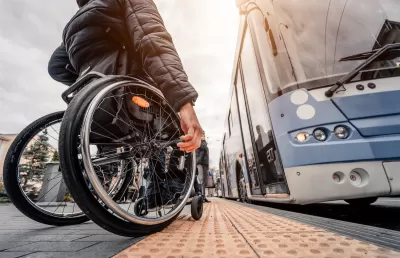One author calls on planners to challenge assumptions that exclude people with mobility challenges and other disabilities.

In a piece in The Conversation, Ronald Norman Buliung presents a new take on the 15-minute city, a planning concept that promotes walkable, compact neighborhoods. For Buliung, the approach “relies on ableist assumptions.”
“The 15-minute city relies on residents’ abilities to walk and bike. This raises several questions: What if a resident’s body doesn’t walk or bike in what is considered a normative sense? What if someone uses a mobility device or moves at a slower pace? What if a resident requires public or school transportation vehicles to be adapted? ”
Buliung argues that the existing regulatory frameworks governing accessibility “reveal an emphasis on physical disability and serious limitations in terms of revision and enforcement.” Thus, “It would therefore be foolish to rely on such a relatively inflexibly narrow regulatory environment to make up for any ableist limitations of planning concepts used to shape sustainable, inclusive urban futures.”
Noting that disability is often an afterthought in planning, Buliung suggests that, from the beginning of the planning process, planners should “consider what cities or neighbourhoods might look like when designed with disability in mind.”
FULL STORY: The 15-minute city is a popular planning approach, but relies on ableist assumptions

Study: Maui’s Plan to Convert Vacation Rentals to Long-Term Housing Could Cause Nearly $1 Billion Economic Loss
The plan would reduce visitor accommodation by 25,% resulting in 1,900 jobs lost.

North Texas Transit Leaders Tout Benefits of TOD for Growing Region
At a summit focused on transit-oriented development, policymakers discussed how North Texas’ expanded light rail system can serve as a tool for economic growth.

Why Should We Subsidize Public Transportation?
Many public transit agencies face financial stress due to rising costs, declining fare revenue, and declining subsidies. Transit advocates must provide a strong business case for increasing public transit funding.

How to Make US Trains Faster
Changes to boarding platforms and a switch to electric trains could improve U.S. passenger rail service without the added cost of high-speed rail.

Columbia’s Revitalized ‘Loop’ Is a Hub for Local Entrepreneurs
A focus on small businesses is helping a commercial corridor in Columbia, Missouri thrive.

Invasive Insect Threatens Minnesota’s Ash Forests
The Emerald Ash Borer is a rapidly spreading invasive pest threatening Minnesota’s ash trees, and homeowners are encouraged to plant diverse replacement species, avoid moving ash firewood, and monitor for signs of infestation.
Urban Design for Planners 1: Software Tools
This six-course series explores essential urban design concepts using open source software and equips planners with the tools they need to participate fully in the urban design process.
Planning for Universal Design
Learn the tools for implementing Universal Design in planning regulations.
City of Santa Clarita
Ascent Environmental
Institute for Housing and Urban Development Studies (IHS)
City of Grandview
Harvard GSD Executive Education
Toledo-Lucas County Plan Commissions
Salt Lake City
NYU Wagner Graduate School of Public Service





























